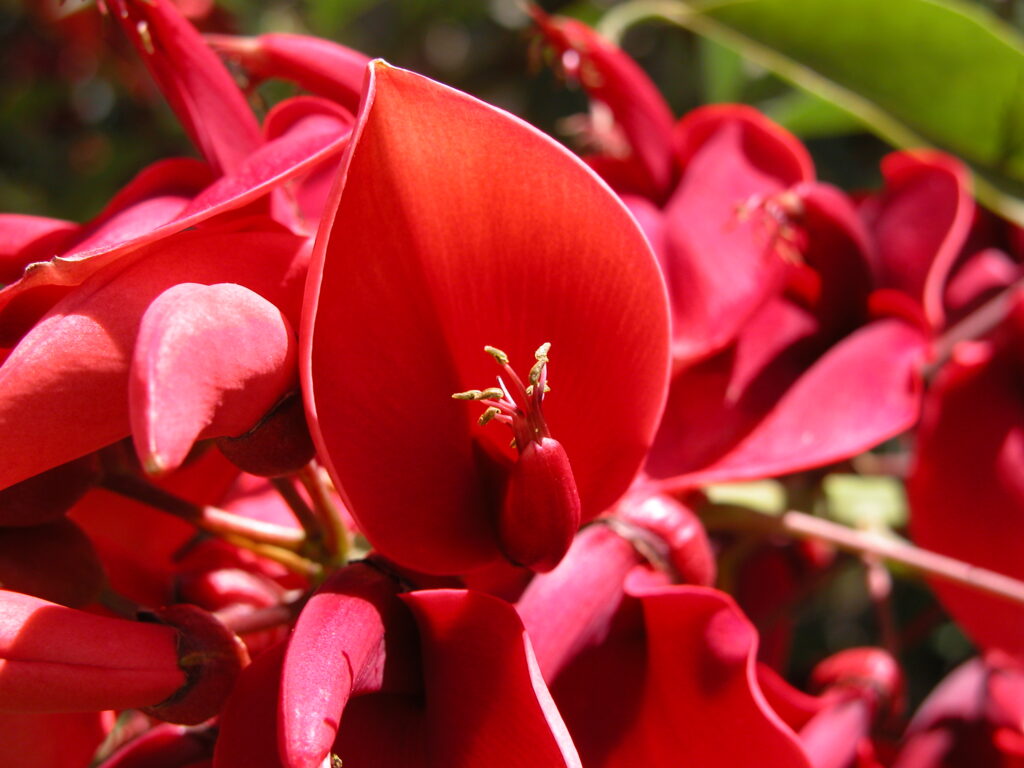
FidelIvanS, CC BY-SA 4.0
Uruguay
Ceibo
Erythrina crista-galli

FidelIvanS, CC BY-SA 4.0
General Description / Cultural Significance
The Ceibo tree (Erythrina crista-galli), also commonly known as the Cockspur Coral Tree, is a tropical, deciduous tree with pinkish-orange fragrant tubular flowers that bloom primarily from late winter into late fall and are rich in nectar. Throughout the rest of the year, its thin and translucent leaves change from a dark chartreuse to a vibrant autumn yellow, and then back to green again. The Ceibo tree thrives best in environments full of sunlight and decent moisture. At full maturity, it can reach up to 30 feet tall.
Uruguay declared the Ceibo as its national flower in 1952 to honor its long-held cultural significance in folklore art and to celebrate the tree as a representation of strength and resilience. By adopting the Ceibo as its national flower, Uruguay acknowledges its role as a symbol of bravery and a reminder of the strength and vitality that characterize the Uruguayan spirit. In many other South American countries, the Ceibo carries a culturally similar message. Typically cultivated and harvested for ornamental and aesthetic purposes, the Ceibo is also used for making cellulose paste for binders in materials like glue, dyes, or wax drawing utensils. It has a long history of use in Uruguayan traditional medicine as a sedative, relaxant, anti-malarial, and anti-inflammatory, primarily consumed as a tea. New pharmacological research has shown that the plant can help treat several diseases due to its flavonoids and polyphenols.
The Ceibo became widespread through buoyant seeds that disperse themselves via water. Originating in California, many of the seeds that ultimately made their way to Uruguay and other parts of South America were spread through bird feces.
Climate Change / Conservation Status
This tree species has a large international distribution and population and is not currently facing any immediate or pressing threats. Forested areas in Uruguay normally get regular rain and plenty of sun, perfect for Ceibo’s need for moist soils and full sun.
Despite a severe drought crisis in 2023 that surprisingly and dramatically affected the country, Uruguay is back to enjoying fresh water and the prospects for agricultural abundance are good. Very important for a country where over 87 percent of its land mass is in agricultural use.
Alternate Names:
Cockspur Coral Tree
Sources:
“Erythrina Crista-Galli.” Erythrina Crista-Galli – Plant Finder, www.missouribotanicalgarden.org/PlantFinder/PlantFinderDetails.aspx?taxonid=280318. Accessed 7 May 2024.
Lee, Shuyun. “Tree Spotlight: Cockspur Coral.” Canopy, 30 Nov. 2022, canopy.org/blog/tree-spotlight-cockspur-coral/.
Office of the Ambassador, Permanent Mission of Uruguay to the United Nations. Full statement on World Sensorium original website.
Susilawati, Elis, et al. “Pharmacology Activity, Toxicity, and Clinical Trials of Erythrina Genus Plants (Fabaceae): An Evidence-Based Review.” Frontiers in Pharmacology, U.S. National Library of Medicine, 16 Nov. 2023, www.ncbi.nlm.nih.gov/pmc/articles/PMC10690608/.
“The IUCN Red List of Threatened Species.” IUCN Red List of Threatened Species, 12 June 2018, www.iucnredlist.org/species/144285016/149059795#assessment-information. “Uruguay.” Central Intelligence Agency, Central Intelligence Agency, 22 May 2024, www.cia.gov/the-world-factbook/countries/uruguay/#environment.

